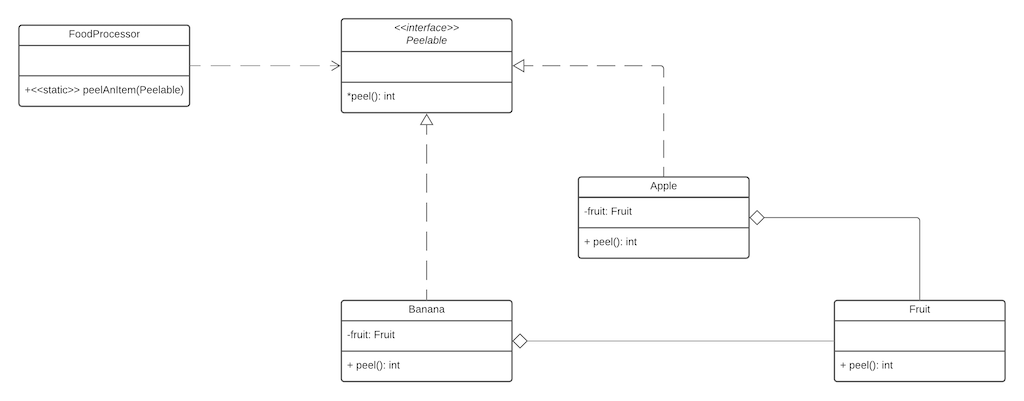The Fragile Base Class Problem
The fragile base class problem is caused by the use of implementation inheritance. It occurs when a derived class extends a base class, using some of the methods or attributes in the base class.

The derived class is tightly coupled to the base class. This is because the derived class expects the methods or attributes of the base class that it uses, to be of a certain type, or do things in a certain way. This means you cannot modify the base class without having to examine every derived class that inherits from the base class, and the client code that uses either the base or derived class objects.
Let's look at an example to illustrate the problem.
class Fruit {
// Return int number of pieces of peel that resulted from the peeling activity
public int peel() {
return 1;
}
}
class Apple extends Fruit { }
class Example1 {
public static void main(String[] args) {
Apple apple = new Apple();
int pieces = apple.peel();
}
}
What would happen if you changed the return type of peel from int to the type Peel?
The client code now no longer works as it is expecting an int to be returned, even though the class Example1 never explicitly mentions the Fruit class
coupling The undesirable reliance of one part of a program on another part
Code Reuse via Composition
Composition provides an alternative way for Apple to reuse Fruit's implementation of peel(). Instead of extending Fruit, Apple can hold a reference to a Fruit instance and define its own peel() method that simply invokes peel() on the Fruit.
class Fruit {
// Return int number of pieces of peel that resulted from the peeling activity
public int peel() {
return 1;
}
}
class Apple extends Fruit {
private Fruit fruit = new Fruit();
public int peel() {
return fruit.peel();
}
}
class Example2 {
public static void main(String[] args) {
Apple apple = new Apple();
int pieces = apple.peel();
}
}
The composition approach to code reuse provides stronger encapsulation than inheritance, because a change to a back-end class (Fruit) needn't break any code that relies only on the front-end class. For example, changing the return type of Fruit's peel() method from an int to a Peel doesn't force a change in Apple's interface and therefore needn't break class Example2
class Fruit {
// Return Peel number of pieces of peel that resulted from the peeling activity
public Peel peel() {
return Peel(1);
}
}
class Apple extends Fruit {
// Apple must be changed to accommodate the change to Fruit
private Fruit fruit = new Fruit();
public int peel() {
Peel peel = fruit.peel();
return peel.getPeelCount();
}
}
class Example2 {
public static void main(String[] args) {
Apple apple = new Apple();
int pieces = apple.peel();
}
}
Obtaining Polymorphism Using Composition
Polymorphism is still possible when using composition, but we need to use type inheritance to gain a common parent type.
In the diagram, the FoodProcessor can peel anything that implements Peelable since these objects all inherit the Peelable type.
Note that there is polymorphism with the subtypes of Peelable using peel(), but the peel implementation is always delegated to Fruit.